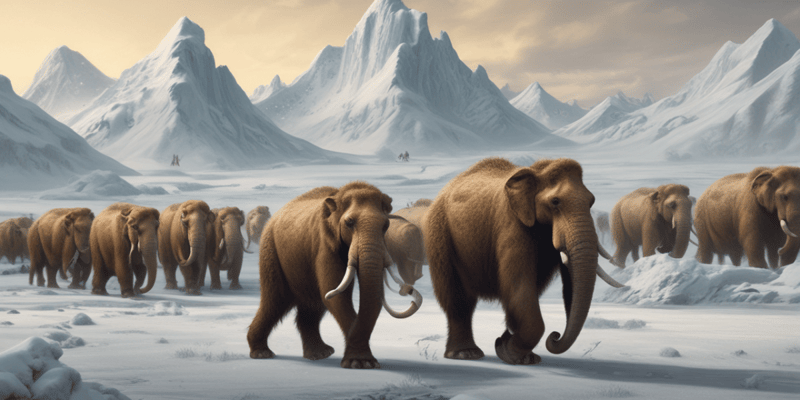Questions and Answers
What is unique about teardrop-shaped points from Baralek and Ushki Layer 7 in Siberia?
They date back to around 13,500 years ago.
What is common to both Ushki-1 site in Siberia and Upward Sun River in Alaska?
Both sites contain stone tools and beads.
Why may caves be more likely to contain early archaeological sites?
They preserve ancient sediments and had ritual and practical value to Paleolithic humans.
What is a promising strategy for finding more Beringian sites?
Signup and view all the answers
What is special about the Upward Sun River site in Alaska?
Signup and view all the answers
How many Beringian burial sites are currently known?
Signup and view all the answers
What was the primary reason for the migration of ice age people?
Signup and view all the answers
What was Alaska a part of during the ice age?
Signup and view all the answers
What is Perindia believed to be?
Signup and view all the answers
What are some of the challenges in studying Beringia?
Signup and view all the answers
What type of ecosystem dominated Beringia?
Signup and view all the answers
What is the estimated age of the Nepa 1 site in Siberia?
Signup and view all the answers
What was found at the Iana Rhinohorn site in Siberia?
Signup and view all the answers
What was the purpose of the Swan Point site in Alaska?
Signup and view all the answers
Study Notes
Ice Age People and Climate
- The push and pull of the climate, human curiosity, and the movement of other animals drove the migration of ice age people.
- Alaska belonged to the Old World during the ice age, with ice sheets forming a barrier across much of Canada.
- The Bering Sea was dry, allowing people to walk from Siberia to Alaska.
Perindia: A Destination and Not Just a Stopping Point
- Perindia was a vast conjoined land that was a whole subcontinent, not just a stopping point on the journey to the New World.
- It had thousands of years of pre-history that has barely been studied.
Challenges in Studying Beringia
- Decades of research have not fully understood Beringia due to:
- Small modern populations
- Few archaeologists
- High costs of conducting research
- Low levels of development
- Deeply buried sites in frozen contexts and hidden under thick boreal forest and tundra are complicated to discover and reach.
The Mammoth Ecosystem
- Beringia was dominated by mammoth steppes, vast arid grasslands filled with a menagerie of large mammals.
- The collective behavior of millions of competitive herbivores maintained the grasslands.
- In the winter, the animals ate the grasses that grew the previous summer, fertilizing the soil with their manure and trampling down moss and shrubs.
Sites in Beringia
- Nepa 1 site in Siberia dates to at least 30,000 years ago, with a small assemblage of stone artifacts and associated remains of large mammals.
- Iana Rhinohorn site in Siberia has a well-preserved cultural layer with numerous stone and bone artifacts, including a projectile foreshaft carved from the horn of a woolly rhino.
- Bluefish Caves in Canada's Yukon territory dates to between 18,000 and 24,000 years old, with cut-marked bones and flaked bones found without other man-made artifacts.
- Swan Point site in Alaska dates to 14,400 years ago, with people camping, hunting, and scavenging along a major transportation corridor.
Microblades and Burials
- Microblades represent an interesting technological departure from what is seen south of the ice sheets.
- Teardrop-shaped points from Baralek and Ushki Layer 7 in Siberia date to as early as 13,500 years ago.
- There are only two Beringian burial sites currently known, one in Siberia and one in Alaska.
- Ushki-1 site in Siberia contains several burials, including a single adult laid within a rock-lined pit filled with ochre, stone beads, and stone tools.
- Upward Sun River in Alaska contains a child burial with two infants, four antler rods, and two bifacial points.
Finding More Sites
- Caves may provide a disproportionate share of the earliest archaeological sites around the world due to their preservation of ancient sediments and ritual and practical value to Paleolithic humans.
- Alaska has limestone deposits in which caves could have formed, including in sections of the interior that remained unglaciated during the last ice age.
- Surveying for caves may be one of the best bets for finding traces of Beringia.
Ice Age People and Climate
- Human migration during the ice age was driven by climate, human curiosity, and animal movement.
- Alaska was part of the Old World during the ice age, separated from the rest of the continent by ice sheets.
- The Bering Sea was dry, allowing people to walk from Siberia to Alaska.
Perindia: A Destination and Not Just a Stopping Point
- Perindia was a vast conjoined land, not just a stopping point on the journey to the New World.
- Perindia has thousands of years of pre-history that has barely been studied.
Challenges in Studying Beringia
- Studying Beringia is challenging due to:
- Small modern populations
- Few archaeologists
- High research costs
- Low levels of development
- Sites in Beringia are difficult to discover and reach due to being deeply buried in frozen contexts and hidden under thick boreal forest and tundra.
The Mammoth Ecosystem
- Beringia was dominated by mammoth steppes, vast arid grasslands filled with large mammals.
- The collective behavior of millions of competitive herbivores maintained the grasslands.
- In the winter, the animals ate the grasses, fertilizing the soil with their manure and trampling down moss and shrubs.
Sites in Beringia
- Nepa 1 site in Siberia dates to at least 30,000 years ago, with stone artifacts and large mammal remains.
- Iana Rhinohorn site in Siberia has a well-preserved cultural layer with stone and bone artifacts, including a projectile foreshaft carved from a woolly rhino horn.
- Bluefish Caves in Canada's Yukon territory dates to between 18,000 and 24,000 years old, with cut-marked bones and flaked bones.
- Swan Point site in Alaska dates to 14,400 years ago, with evidence of camping, hunting, and scavenging along a major transportation corridor.
Microblades and Burials
- Microblades represent a technological departure from what is seen south of the ice sheets.
- Teardrop-shaped points from Baralek and Ushki Layer 7 in Siberia date to as early as 13,500 years ago.
- There are only two Beringian burial sites currently known, one in Siberia and one in Alaska.
- Ushki-1 site in Siberia contains several burials, including a single adult laid within a rock-lined pit with ochre, stone beads, and stone tools.
- Upward Sun River in Alaska contains a child burial with two infants, four antler rods, and two bifacial points.
Finding More Sites
- Caves may provide a disproportionate share of the earliest archaeological sites due to their preservation of ancient sediments and ritual and practical value to Paleolithic humans.
- Alaska has limestone deposits in which caves could have formed, including in sections of the interior that remained unglaciated during the last ice age.
- Surveying for caves may be one of the best bets for finding traces of Beringia.
Studying That Suits You
Use AI to generate personalized quizzes and flashcards to suit your learning preferences.
Description
Learn about the migration of ice age people driven by climate, human curiosity, and animal movement, and explore Perindia, a vast conjoined land that was a destination, not just a stopping point.




